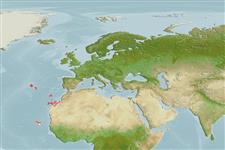Issue
Will eventually be assigned to a new genus.
Environment: milieu / climate zone / depth range / distribution range
Écologie
marin récifal; non migrateur; profondeur 0 - 25 m. Subtropical; 40°N - 13°N, 29°W - 11°W (Ref. 56021)
Eastern Atlantic: including Madeira, Azores, Ilheus Selvagens, Canary Islands, Cape Verde, and Senegal.
Taille / Poids / Âge
Maturity: Lm ? range ? - ? cm
Max length : 15.0 cm TL mâle / non sexé; (Ref. 27000)
Description synthétique
Clés d'identification | Morphologie | Morphométrie
Épines dorsales (Total) : 13; Rayons mous dorsaux (Total) : 16 - 17; Épines anales: 2; Rayons mous anaux: 13 - 14.
Adults inhabit rocky inshore areas, often near sand; juveniles found in tide pools. Food comprised mainly of algae with associated minute invertebrates (Ref. 6760). Males protect the eggs deposited in nests (Ref. 6760).
Life cycle and mating behavior
Maturities | Reproduction | Spawnings | Egg(s) | Fecundities | Larves
Oviparous, distinct pairing during breeding (Ref. 205). Eggs are demersal and adhere to the substrate (Ref. 205). Males protect the eggs deposited in nests (Ref. 6760).
Allen, G.R., 1991. Damselfishes of the world. Mergus Publishers, Melle, Germany. 271 p. (Ref. 7247)
Statut dans la liste rouge de l'IUCN (Ref. 130435)
Menace pour l'homme
Harmless
Utilisations par l'homme
Outils
Articles particuliers
Télécharger en XML
Sources Internet
Estimates based on models
Preferred temperature (Ref.
123201): 18.7 - 24.5, mean 20.2 °C (based on 85 cells).
Phylogenetic diversity index (Ref.
82804): PD
50 = 0.7500 [Uniqueness, from 0.5 = low to 2.0 = high].
Bayesian length-weight: a=0.01259 (0.00490 - 0.03233), b=3.04 (2.82 - 3.26), in cm total length, based on LWR estimates for this (Sub)family-body shape (Ref.
93245).
Niveau trophique (Ref.
69278): 3.5 ±0.37 se; based on food items.
Résilience (Ref.
120179): Haut, temps minimum de doublement de population inférieur à 15 mois (Preliminary K or Fecundity.).
Fishing Vulnerability (Ref.
59153): Low vulnerability (10 of 100).
Climate Vulnerability (Ref.
125649): High to very high vulnerability (71 of 100).
Nutrients (Ref.
124155): Calcium = 54.3 [24.9, 116.4] mg/100g; Iron = 0.693 [0.403, 1.170] mg/100g; Protein = 19.7 [18.7, 20.7] %; Omega3 = 0.234 [0.135, 0.397] g/100g; Selenium = 10.1 [4.9, 20.4] μg/100g; VitaminA = 85.5 [28.8, 262.9] μg/100g; Zinc = 1.07 [0.69, 1.62] mg/100g (wet weight);
